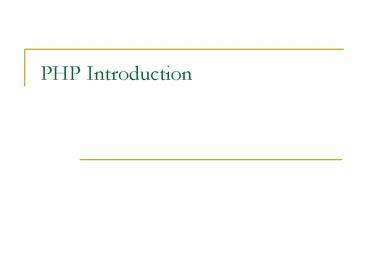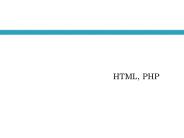PHP Introduction - PowerPoint PPT Presentation
Title:
PHP Introduction
Description:
Code declaration blocks are separate sections within a Web page that are ... 'Anesthesia', // first element(0) 'Molecular Biology', // second element (1) ... – PowerPoint PPT presentation
Number of Views:57
Avg rating:3.0/5.0
Title: PHP Introduction
1
PHP Introduction
2
Creating PHP Code Blocks
- Code declaration blocks are separate sections
within a Web page that are interpreted by the
scripting engine - There are four types of code declaration blocks
- Standard PHP script delimiters
- The ltscriptgt element
- Short PHP script delimiters
3
Standard PHP Script Delimiters
- A delimiter is a character or sequence of
characters used to mark the beginning and end of
a code segment - The standard method of writing PHP code
declaration blocks is to use the lt?php and ?gt
script delimiters - The individual lines of code that make up a PHP
script are called statements
4
The ltscriptgt Element
- The ltscriptgt element identifies a script section
in a Web page document - For client-side scripting, the type attribute of
the ltscriptgt element indicates which scripting
language and version is being used - When the ltscriptgt element is used with PHP, you
do not include the type attribute
5
Short PHP Script Delimiters
- The syntax for the short PHP script delimiters is
- lt? statements ?gt
- Short delimiters can be disabled in a Web
servers php.ini configuration file - PHP scripts will not work if your Web site ISP
does not support short PHP script delimiters
6
Displaying Script Results
- To return to the client the results of any
processing that occurs within a PHP code block,
you must use an echo() statement or the print()
statement - The echo() and print() statements create new text
on a Web page that is returned as a response to a
client
7
Displaying Script Results (continued)
- The echo() and print() statements are language
constructs of the PHP programming language - A programming language construct refers to a
built-in feature of a programming language - The echo() and print() statements are virtually
identical except - The print() statement returns a value of 1 if it
is successful - It returns a value of 0 if it is not successful
8
Displaying Script Results
- Use the echo() and print() statements to return
the results of a PHP script within a Web page
that is returned to a client - A text string, or literal string, is text that is
contained within double or single quotation marks - To pass multiple arguments to the echo() and
print() statements, separate them with commas
like arguments passed to a function
9
Creating Multiple Code Declaration Blocks
- For multiple script sections in a document,
include a separate code declaration block for
each section - ...
- lt/headgt
- ltbodygt
- lth1gtMultiple Script Sectionslt/h1gt
- lth2gtFirst Script Sectionlt/h2gt
- lt?php echo ltpgtOutput from the first script
section.lt/pgt - ?gt
- lth2gtSecond Script Sectionlt/h2gt
- lt?php echo ltpgtOutput from the second script
section.lt/pgt - ?gt
- lt/bodygt
- lt/htmlgt
10
Creating Multiple Code Declaration Blocks
- PHP code declaration blocks execute on a Web
server before a Web page is sent to a client - ...
- lt/headgt
- ltbodygt
- lth1gtMultiple Script Sectionslt/h1gt
- lth2gtFirst Script Sectionlt/h2gt
- ltpgtOutput from the first script section.lt/pgt
- lth2gtSecond Script Sectionlt/h2gt
- ltpgtOutput from the second script section.lt/pgt
- lt/bodygt
- lt/htmlgt
11
Creating Multiple Code Declaration Blocks
- Figure 2-17 Output of a document with two PHP
script sections
12
Case Sensitivity in PHP
- Programming language constructs in PHP are mostly
case insensitive - lt?php
- echo ltpgtExplore ltstronggtAfricalt/stronggt, ltbr
/gt - Echo ltstronggtSouth Americalt/stronggt, ltbr /gt
- ECHO and ltstronggtAustralialt/stronggt!lt/pgt
- ?gt
13
Adding Comments to a PHP Script
- Comments are nonprinting lines placed in code
such as - The name of the script
- Your name and the date you created the program
- Notes to yourself
- Instructions to future programmers who might need
to modify your work
14
Adding Comments to a PHP Script (continued)
- Line comments hide a single line of code
- Add // or before the text
- Block comments hide multiple lines of code
- Add / to the first line of code
- And / after the last character in the code
15
Adding Comments to a PHP Script (continued)
- lt?php
- /
- This line is part of the block comment.
- This line is also part of the block comment.
- /
- echo lth1gtComments Examplelt/h1gt // Line
comments can follow - code statements
- // This line comment takes up an entire line.
- This is another way of creating a line comment.
- / This is another way of creating
- a block comment. /
- ?gt
16
Using Variables and Constants
- The values stored in computer memory are called
variables - The values, or data, contained in variables are
classified into categories known as data types - The name you assign to a variable is called an
identifier and it - Must begin with a dollar sign ()
- Cannot include spaces
- Is case sensitive
17
Declaring and Initializing Variables
- Specifying and creating a variable name is called
declaring the variable - Assigning a first value to a variable is called
initializing the variable - In PHP, you must declare and initialize a
variable in the same statement - variable_name value
18
Displaying Variables
- To print a variable with the echo() statement,
pass the variable name to the echo() statement
without enclosing it in quotation marks - VotingAge 18Echo VotingAge
- To print both text strings and variables, send
them to the echo() statement as individual
arguments, separated by commas - echo "ltpgtThe legal voting age is ", VotingAge,
".lt/pgt"
19
Defining Constants
- A constant contains information that does not
change during the course of program execution - Constant names do not begin with a dollar sign
() - Constant names use all uppercase letters
- Use the define() function to create a constant
- define("CONSTANT_NAME", value)
- The value you pass to the define() function can
be a text string, number, or Boolean value
20
Working with Data Types
- A data type is the specific category of
information that a variable contains - Data types that can be assigned only a single
value are called primitive types - Table 3-1 Primitive PHP data types
21
Working with Data Types (continued)
- The PHP language supports
- A resource data type a special variable that
holds a reference to an external resource such
as a database or XML file - Reference or composite data types, which contain
multiple values or complex types of information - Two reference data types arrays and objects
22
Working with Data Types (continued)
- Strongly typed programming languages require you
to declare the data types of variables - Static or strong typing refers to data types that
do not change after they have been declared - Loosely typed programming languages do not
require you to declare the data types of
variables - Dynamic or loose typing refers to data types that
can change after they have been declared
23
Numeric Data Types
- PHP supports two numeric data types
- An integer is a positive or negative number with
no decimal places (-250, 2, 100, 10,000) - A floating-point number is a number that contains
decimal places or that is written in exponential
notation (-6.16, 3.17, 2.7541) - Exponential notation, or scientific notation, is
short for writing very large numbers or numbers
with many decimal places (2.0e11)
24
Boolean Values
- A Boolean value is a value of true or false
- It decides which part of a program should execute
and which part should compare data - In PHP programming, you can only use true or
false - In other programming languages, you can use
integers such as 1 true, 0 false
25
Arrays
- An array contains a set of data represented by a
single variable name - Figure 3-7 Conceptual example of an array
26
Declaring and Initializing Indexed Arrays
- An element refers to each piece of data that is
stored within an array - By default, it starts with the number zero (0)
- An index is an elements numeric position within
the array - Referenced by enclosing its index in brackets at
the end of the array name - Provinces1
27
Creating an Array
- The array() construct syntax is
- array_name array(values)
- Provinces array(
- "Newfoundland and Labrador",
- "Prince Edward Island",
- "Nova Scotia",
- "New Brunswick",
- "Quebec",
- "Ontario",
- "Manitoba",
- "Saskatchewan",
- "Alberta",
- "British Columbia"
- )
28
Creating an Array (continued)
- Array name and brackets syntax is
- array_name
- Provinces "Newfoundland and Labrador"
- Provinces "Prince Edward Island"
- Provinces "Nova Scotia"
- Provinces "New Brunswick"
- Provinces "Quebec"
- Provinces "Ontario"
- Provinces "Manitoba"
- Provinces "Saskatchewan"
- Provinces "Alberta"
- Provinces "British Columbia"
29
Accessing Element Information
- echo "ltpgtCanada's smallest province is
Provinces1.ltbr /gt" - echo "Canada's largest province is
Provinces4.lt/pgt" - Figure 3-8 Output of elements in the
Provinces array
30
count() Function
- Use the count() function to find the total number
of elements in an array - Provinces array("Newfoundland and Labrador",
"Prince Edward Island", "Nova Scotia", "New
Brunswick", "Quebec", "Ontario", " Manitoba",
"Saskatchewan", "Alberta", "British Columbia") - Territories array("Nunavut", "Northwest
Territories", "Yukon Territory") - echo "ltpgtCanada has ",count(Provinces),"
provinces and ", - count(Territories), territories.lt/pgt"
31
count() Function (continued)
- Figure 3-9 Output of the count()
function
32
print_r(), var_export(), and var_dump() Functions
- Use to print or return information about
variables - Most useful with arrays because they print the
index and value of each element - Figure 3-11 Output of the Provinces
array with the print_r() function
33
Modifying Elements
- Include the index for an individual element of
the array - HospitalDepts array(
- "Anesthesia", // first element(0)
- "Molecular Biology", // second element (1)
- "Neurology") // third element (2)To change
the first array element in the HospitalDepts
array from Anesthesia to Anesthesiology use - HospitalDepts0 "Anesthesiology"
34
Building Expressions
- An expression is a literal value or variable that
can be evaluated by the PHP scripting engine to
produce a result - Operands are variables and literals contained in
an expression - A literal is a value such as a literal string or
a number - Operators are symbols () () that are used in
expressions to manipulate operands
35
Building Expressions (continued)
- Table 3-2 PHP Operator Types
36
Building Expressions (continued)
- A binary operator requires an operand before and
after the operator - A unary operator requires a single operand either
before or after the operator
37
Arithmetic Operators
- Arithmetic operators are used in PHP to perform
mathematical calculations ( - x ) - Table 3-3 PHP arithmetic binary operators
38
Arithmetic Operators (continued)
- Figure 3-12 Results of arithmetic expressions
39
Arithmetic Operators (continued)
- DivisionResult 15 / 6
- ModulusResult 15 6
- echo "ltpgt15 divided by 6 is
- DivisionResult.lt/pgt" // prints '2.5'
- echo "The whole number 6 goes into 15 twice, with
a - remainder of ModulusResult.lt/pgt" // prints
'3' - Figure 3-13 Division and modulus
expressions
40
Arithmetic Unary Operators
- The increment () and decrement (--) unary
operators can be used as prefix or postfix
operators - A prefix operator is placed before a variable
- A postfix operator is placed after a variable
41
Arithmetic Unary Operators (continued)
- Table 3-4 PHP arithmetic unary operators
42
Arithmetic Unary Operators (continued)
- Figure 3-14 Script that uses the prefix
increment operator
43
Arithmetic Unary Operators (continued)
- Figure 3-15 Output of the prefix version of the
student ID script
44
Arithmetic Unary Operators (continued)
- Figure 3-16 Script that uses the postfix
increment operator
45
Arithmetic Unary Operators (continued)
- Figure 3-17 Output of the postfix version of the
student ID script
46
Assignment Operators
- Assignment operators are used for assigning a
value to a variable - MyFavoriteSuperHero "Superman"
- MyFavoriteSuperHero "Batman"
- Compound assignment operators perform
mathematical calculations on variables and
literal values in an expression, and then assign
a new value to the left operand
47
Assignment Operators (continued)
- Table 3-5 PHP assignment operators
48
Comparison and Conditional Operators
- Comparison operators are used to compare two
operands and determine how one operand compares
to another - A Boolean value of true or false is returned
after two operands are compared - The comparison operator compares values, whereas
the assignment operator assigns values - Comparison operators are used with conditional
statements and looping statements
49
Comparison and Conditional Operators (continued)
- Table 3-6 PHP comparison operators
50
Comparison and Conditional Operators (continued)
- The conditional operator executes one of two
expressions, based on the results of a
conditional expression - The syntax for the conditional operator is
- conditional expression ? expression1
expression2 - If the conditional expression evaluates to true,
expression1 executes - If the conditional expression evaluates to false,
expression2 executes
51
Comparison and Conditional Operators (continued)
- BlackjackPlayer1 20(BlackjackPlayer1 lt 21)
? Result "Player 1 is still in the game.
Result "Player 1 is out of the
action."echo "ltpgt", Result, "lt/pgt" - Figure 3-21 Output of a script with a
conditional operator
52
Logical Operators
- Logical operators are used for comparing two
Boolean operands for equality - A Boolean value of true or false is returned
after two operands are compared - Table 3-7 PHP logical operators
53
Special Operators
- Table 3-8 PHP special operators
54
Type Casting
- Casting or type casting copies the value
contained in a variable of one data type into a
variable of another data type - The PHP syntax for casting variables is
- NewVariable (new_type) OldVariable
- (new_type) refers to the type-casting operator
representing the type to which you want to cast
the variable
55
gettype() function
- Returns one of the following strings, depending
on the data type - Boolean
- Integer
- Double
- String
- Array
- Object
- Resource
- NULL
- Unknown type
56
Understanding Operator Precedence
- Operator precedence refers to the order in which
operations in an expression are evaluated - Associativity is the order in which operators of
equal precedence execute - Associativity is evaluated on a left-to-right or
a right-to-left basis
57
Understanding Operator Precedence
- Table 3-9 Operator precedence in PHP































